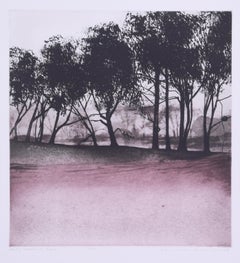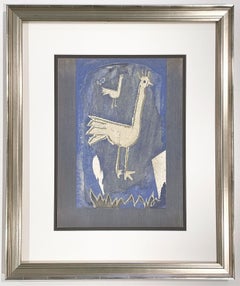George Braque Landscape Prints
French, 1882-1963
Georges Braque was born on May 13, 1882, in Argenteuil-sur-Seine, France. Braque grew up in the town of Le Havre, and studied evenings at the Ecole des Beaux-Arts there from about 1897 to 1899. Braque left for Paris to study under a master decorator to receive his craftsman certificate in 1901. From 1902 to 1904, Braque painted at the Académie Humbert in Paris, where he met Marie Laurencin and Francis Picabia. By 1906, Braque's work was no longer Impressionist but Fauve in style. After spending the summer of that year in Antwerp with Othon Friesz, he showed his Fauve in the 1907 Salon des Indépendants in Paris. His first solo show was at Daniel-Henri Kahnweiler's gallery in 1908.
From 1909 forward, Braque collaborated with Pablo Picasso in developing Cubism, and by 1911, their styles had become extremely similar. In 1912, they started to incorporate collage elements into their paintings and to experiment with the papier collé (pasted paper) technique. Their collaboration lasted until 1914. Braque served in the French army during World War I and was wounded in battle. Upon recovering, he developed a close friendship with the artist Juan Gris. After World War I, Braque's work became less and less schematic and more free. His fame grew in 1922 as a result of an exhibition at the Salon d'Automne in Paris. In the mid-1920s, Braque designed the decor for two Sergei Diaghilev ballets. By the end of the decade, he had returned to a more realistic interpretation of nature, although Cubist elements always remained present in his work.
In 1931, Braque made his first engraved plasters and began to portray mythological subjects. His first important retrospective took place in 1933 at the Kunsthalle Basel. In 1937 he won First Prize at the Carnegie International in Pittsburgh. During World War II, Braque remained in Paris. His paintings at that time, primarily still lifes and interiors, became more somber. In addition to paintings, Braque also made lithographs, engravings, and sculpture. From the late 1940s, he treated various recurring themes, such as birds, ateliers, landscapes, and seascapes. In 1954, he designed stained-glass windows for the Varengeville Church. During the last few years of his life, Braque's ill health prevented him from undertaking further large-scale commissions, but he continued to paint, print lithographs, and design jewelry. He died on August 31, 1963, in Paris.to
1
Overall Width
to
Overall Height
to
1
31
169
158
146
131
1
1
1
1
1
1
1
1
1
Artist: George Braque
Tribute to Cezanne : Estaque Bridge - Original etching, SIGNED (Orozco #776)
By George Braque
Located in Paris, IDF
Georges Braque
Tribute to Cezanne : Estaque Bridge
Original etching with aquatint (Crommelynck workshop)
Signed in pencil
Numbered /150
On BFK Rives vellum 56 x 73 cm (c. 22 x 29 ...
Category
1950s Modern George Braque Landscape Prints
Materials
Etching, Aquatint
Related Items
Early Morning Rain
By Norman Ackroyd
Located in Fairlawn, OH
Early Morning Rain
Etching & color aquatint, 1977
Signed, titled, numbered and dated in pencil
Edition: 40 (39/40)
Published by Associated American Artists, New York
Condition: Mint
...
Category
1970s Modern George Braque Landscape Prints
Materials
Aquatint
Palazzo, Florence
By Rudy O. Pozzatti
Located in Fairlawn, OH
Palazzo, Florence
Etching, engraving, aquatint, soft ground and lift ground, printed in colors from three copper plates. 1954
Signed in pencil lower right (see photo)
Edition 250 plis 10 on Rives wove paper, printed by the artist
Published by The Print Club of Cleveland, No. 33 for 1955
REFERENCE: Geske #32
Condition: Mint
Image size: 9 3/16 x 13 1/8 inches
Impressions of this image can be found in the following museums:
National Gallery of Art, Washington
Toledo Museum of Art
Oberlin, Allen Museum of Art
Cornell Univeristy
Cleveland Museum of Art
Indianapolis Museum of Art
Baltimore Museum of Art
Georgetown University
Indiana Univeristy, Eskenazi Museum of Art
David Museum of Art at Wellesley College
"Painter and printmaker Rudolph Otto "Rudy" Pozzatti was born in Telluride, Colorado, on January 14, 1925. Upon graduation from high school, he received a scholarship to attend the University of Colorado in Boulder where he enrolled as an art major. In 1943, his studies were interrupted by his induction into the U. S. Army. After his discharge in 1946, he re-enrolled in the University of Colorado where he studied under Wendell...
Category
1950s American Modern George Braque Landscape Prints
Materials
Aquatint
Rapunzel, Rapunzel, let down your hair David Hockney Brothers Grimm Fairy Tales
By David Hockney
Located in New York, NY
From David Hockney’s celebrated Six Fairy Tales from the Brothers Grimm portfolio, an image from the story of Rapunzel, which he chose for its popularity. When illustrating the princ...
Category
1960s Modern George Braque Landscape Prints
Materials
Etching, Aquatint
'Riders at Sundown' — Mid-Century Southwest Regionalism
By Gene Kloss
Located in Myrtle Beach, SC
'Riders at Sundown', aquatint and drypoint, edition 75, 1953, Kloss 451. Signed, titled, and annotated 'Artist's Proof' in pencil. A superb, richly-inked, atmospheric impression, in ...
Category
1950s American Modern George Braque Landscape Prints
Materials
Drypoint, Aquatint
The glass mountain shattered David Hockney Fairy Tales from the Brothers Grimm
By David Hockney
Located in New York, NY
This etching from David Hockney’s celebrated Six Fairy Tales from the Brothers Grimm portfolio depicts the somewhat obscure story Old Rinkrank, which Hockney chose to illustrate beca...
Category
1960s Modern George Braque Landscape Prints
Materials
Etching, Aquatint
Wrexham Tower, Yale University
Located in Middletown, NY
Etching with aquatint on watermarked cream laid J Perrigot Arches paper, 15 7/8 x 9 3/4 inches (400 x 248 mm), full margins. Signed, dated, and dedicated to the the artist Ruth Knobl...
Category
Early 20th Century American Modern George Braque Landscape Prints
Materials
Handmade Paper, Etching, Aquatint
The Enchantress with the Baby Rapunzel by David Hockney Brothers Grimm Tales
By David Hockney
Located in New York, NY
From David Hockney’s celebrated Six Fairy Tales from the Brothers Grimm portfolio, an image from the story of Rapunzel. The Enchantress with the baby Rapunzel references a Heironymus...
Category
1960s Modern George Braque Landscape Prints
Materials
Etching, Aquatint
Ludgate Hill
By William Walcot R. E. Hon. R. I. B. A.
Located in Middletown, NY
Etching with drypoint and aquatint on light cream wove paper, 5 1/2 x 5 inches (140 x 122 mm), full margins. Signed in pencil in the lower margin. One of a total of 400 signed impres...
Category
Early 20th Century Modern George Braque Landscape Prints
Materials
Etching, Aquatint, Drypoint
The Enchantress in her Garden David Hockney Fairy Tales from the Brothers Grimm
By David Hockney
Located in New York, NY
From David Hockney’s celebrated Six Fairy Tales from the Brothers Grimm portfolio, an image from the story of Rapunzel. Hockney stated: “The old woman who wants the child. In one tr...
Category
1960s Modern George Braque Landscape Prints
Materials
Etching, Aquatint
Notre Dame de Paris
By John Taylor Arms
Located in Middletown, NY
A superb, dark impression of a well known scene by Arms.
Etching with aquatint on watermarked handmade F.J. Head & Co. laid paper, 12 3/8 x 13 15/16 inches (315 x 354 mm), full marg...
Category
1920s American Modern George Braque Landscape Prints
Materials
Handmade Paper, Laid Paper, Etching, Aquatint
Shadows of Venice
By John Taylor Arms
Located in Middletown, NY
Etching and aquatint on antique laid paper, wide margins. Signed, dated and inscribed "Edition of 100" in pencil, lower margin. Second state (of 2)....
Category
Mid-20th Century American Modern George Braque Landscape Prints
Materials
Laid Paper, Etching, Aquatint
From the Ponte Vecchio, Florence
By John Taylor Arms
Located in Middletown, NY
Etching and aquatint on hand made F.J. Head & Co watermarked cream laid paper, full margins. Signed and dated in pencil, lower right margin. From the edition of 160 (from a total of ...
Category
1920s American Modern George Braque Landscape Prints
Materials
Handmade Paper, Laid Paper, Etching, Aquatint
Previously Available Items
Le Coq
By George Braque
Located in Washington, DC
Artist: Georges Braque
Title: Le Coq
Portfolio: Verve Vol VII No. 27-28
Year: 1952
Signed: Unsigned
Medium: Lithograph
Edition: 6000
Framed Size: 22" x 18 1/4"
...
Category
1950s Cubist George Braque Landscape Prints
Materials
Lithograph
George Braque landscape prints for sale on 1stDibs.
Find a wide variety of authentic George Braque landscape prints available for sale on 1stDibs. You can also browse by medium to find art by George Braque in aquatint, etching and more. Much of the original work by this artist or collective was created during the 1950s and is mostly associated with the modern style. Not every interior allows for large George Braque landscape prints, so small editions measuring 29 inches across are available. Customers who are interested in this artist might also find the work of Jacques Villon, Raoul Dufy, and Robert Delaunay. George Braque landscape prints prices can differ depending upon medium, time period and other attributes. On 1stDibs, the price for these items starts at $3,329 and tops out at $3,329, while the average work can sell for $3,329.
Artists Similar to George Braque
Questions About George Braque Landscape Prints
- Was Georges Braque a Surrealist?1 Answer1stDibs ExpertAugust 29, 2024No, Georges Braque was not a Surrealist. Influenced by Henri Matisse, Braque's early works display the bright colors and emotional symbolism common to Fauvist art. Later in his career, the French artist worked primarily in Cubism alongside his contemporary Pablo Picasso. Shop a selection of Georges Braque art on 1stDibs.
- 1stDibs ExpertApril 5, 2022Georges Braque is known for being one of the leading artists in both the Fauve and Cubist art movements of the early 20th century. The French artist produced paintings, collages, prints and sculptures. On 1stDibs, find a variety of Georges Braque art.


